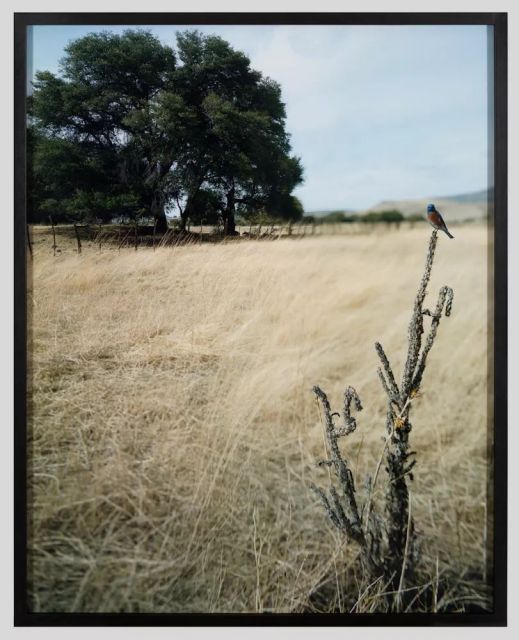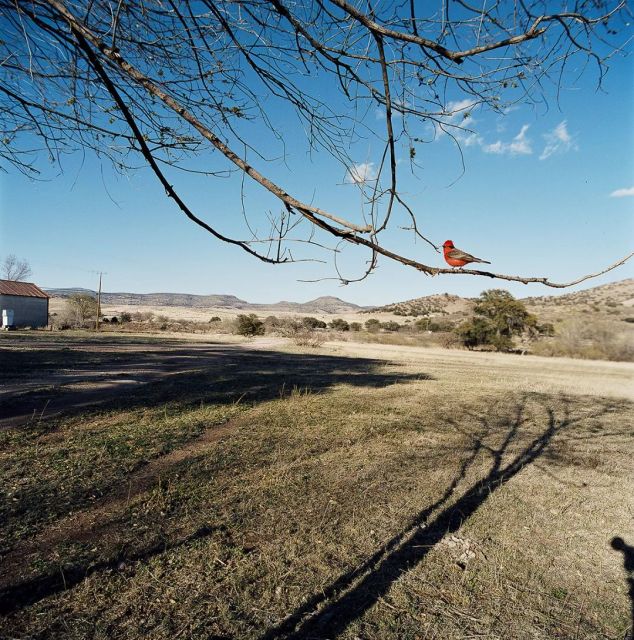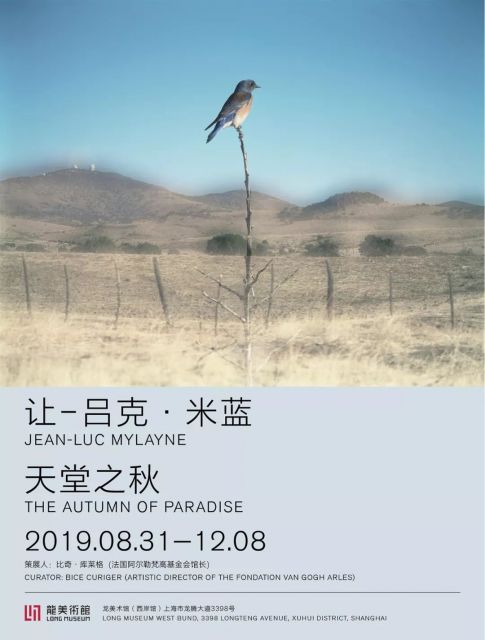How can one compare Vincent van Gogh and Jean-Luc Mylayne? Do we not associate these two names with lives and works that could not be more different from each other? We are certainly not instantly struck by any biographical or stylistic common ground or similarity of subject matter that would justify such a juxtaposition, but at the heart of these two artistic imaginations and the approach they take, we do find an abstract and, indeed, fundamental aspect that merits a closer look. It is the concept of time that crystallizes in their art via their chosen mediums, albeit each with a new “epochal” twist – painting in Van Gogh’s case, photography in Mylayne’s. While Vincent van Gogh accentuated the speed with which he painted in an unprecedented way[], Mylayne adds slowness, the prolongation of time to the process of taking pictures.
—Bice Curiger, curator of “The Autumn of Paradise” and Artistic Director, Fondation Vincent van Gogh Arles
“Jean-Luc Mylayne: The Autumn of Paradise”, is the French artist’s first institutional solo exhibition in mainland China. For more than forty years now, the work of Jean-Luc Mylayne (b. 1946) focuses on the encounter with birds, their fleeting presence captured by the camera. The bird in its natural habitat is Mylayne’s distinctive subject, serving not only as actor but also as conceptual partner on equal terms. Presenting an ensemble of about forty works created between 1979 and 2008, this exhibition, which originated at the Fondation Vincent van Gogh Arles, visually portrays deep conceptual connections between the works of Mylayne and Van Gogh, two artists working in varying mediums at different moments in art history. This connection between the artists is through their respective approaches towards the natural world, crystallizing time through representation, and challenging their era’s dominant way of seeing.
At first glance, Jean-Luc Mylayne’s photographs appear like randomly obtained everyday images situated in the transitional areas between unspoiled and rural landscapes. In addition to dominant nature, one can see traces of human civilization in the form of houses, streets, fences, and walls in the distance or at the edge of the picture. Characteristically, there is a bird in every image. Just as the geographical context of the scenes remains indefinite, the specific features of the birds are at times barely discernible. When the animals are captured in motion, they appear distorted and blurred. Sometimes one detects the winged protagonists only at second glance in the parts of the scenery that are out of focus or at the edge of the picture and partly truncated by it.
This seemingly non-hierarchical image composition does not conform to the perspectives of ornithological studies or classic nature photography which center on the distinctive features of the birds or the unusual flora. Mylayne focuses on the one particular bird as an individual rather than as a specimen of a particular breed. His pictorial compositions are based on a precise choice and combination of lighting conditions, weather, time of year as well as the selection of the frame and the positioning of the bird. Each “tableau” is well thought out; nothing, not even the smallest detail, is random. The images are intricately composed and always comply with the artist’s conceptual approach.

Jean-Luc Mylayne, No. 477, Décembre 2006 – Janvier Février 2007; C-print, 193.7×156.2cm
Thus, Mylayne’s photographs are a far cry from anecdotal snapshots. They are the result of months, sometimes even years of preparation. In the period of time indicated in a work’s title, the artist has explored the surrounding area, observed the selected animal and slowly gained its trust without feeding or taming it. This trust is the fundamental prerequisite for a relationship between the photographer and his subject and, by extension, for creating the image. When the moment has come and the scenery meets his expectations, Mylayne takes the photograph. Working with analogue technology, Mylayne’s photographs are unique prints (except for some small-format editions). Equally unique is the moment when the artist presses the shutter release button: a moment that will never return.
Together with Mylène Mylayne, his wife, collaborator and namesake, the photographer travelled through rural France and the American Southwest. In 2003, the American Lannan Foundation first made it possible for the couple to spend the winter New Mexico. Four back-to-back winters in Texas followed. Mylayne’s works of this “American period” are characterised by the resounding blue of the sky contrasting with the golden-yellow landscape. The flying protagonists are usually smaller songbirds. No larger birds of prey are featured in Mylayne’s pictures. Here, too, his focus seems to be on the ordinary, with the uniqueness of the bird and the moment revealing themselves only on closer inspection.

Jean-Luc Mylayne, N°301, Mars Avril 2005; C-print, 123×123cm, 2005, Copyright Jean-Luc Mylayne, Courtesy the artist and Gladstone Gallery, New York and Brussels
With all its premises – the use of analogue photography, the making of unique prints, the focus on the same subject over several decades and, above all, the long time needed to produce each individual work – Jean-Luc Mylayne has created an artistic oeuvre that is as radical as it is poetic and, to this day, remains unparalleled.
For the exhibition at Long Museum West Bund, the artist couple developed a hanging adapted to the bright galleries of Gallery 2. The arrangement of the works is deliberately not chronological but rather based on associative thematic groups.
A joint project with the Fondation Vincent van Gogh in Arles, France, and the Aargauer Kunsthaus, Aarau, Switzerland, the exhibition will travel to the Kestner Gesellschaft in Hanover and Huis Marseille, Museum for Photography in Amsterdam following its presentation in Shanghai.
Catalogue
In 2018, a comprehensive catalogue has been published in cooperation with the Fondation Vincent van Gogh in Arles. It includes a preface by Madeleine Schuppli (German/English edition). The monograph assembles essays by renowned authors Bice Curiger (CH), Director Fondation Vincent van Gogh; Jacqueline Burckhardt (CH), art historian; Christie Davis (USA), Program Director, Contemporary Art and Public Programs, Lannan Foundation; and Leo Lencsés (DE), curator and art critic; as well as the poem The Autumn of Paradise by Jean-Luc Mylayne.
About the Artist
Born in 1946 in France, Jean-Luc Mylayne lives and works in the world. Selected Solo Exhibitions: Jean-Luc Mylayne: Mutual Regard, The Art Institute of Chicago, The Arts Club of Chicago, Lurie Garden, Millennium Park, Chicago (2015); Jean-Luc Mylayne: Des signatures du ciel aux mains du temps, Museo Nacional Centro de Arte Reina Sofia, Madrid (2010); Jean-Luc Mylayne: Tête d’or, Musée d’Art contemporain de Lyon (2009); Jean-Luc Mylayne, Parrish Art Museum, Southampton, New York (2007–09); Jean-Luc Mylayne, Lannan Foundation, Santa Fe, New Mexico (2004, 2005, 2010); Jean-Luc Mylayne: les oies sauvages riaient et Dieu s’endormit tôt, Musée des Arts contemporains, Grand-Hornu, Hornu, Belgium (2004); Jean-Luc Mylayne, Musée d’Art moderne de la Ville de Paris / ARC, Paris (1995); Jean-Luc Mylayne, Musée d’Art moderne, Saint-Étienne (1991). Selected Group Exhibitions: The Photographic I – Other Pictures, S.M.A.K., Gand, Belgium (2017); ILLUMInations, 54th Venice Biennale (2011); Terra Incognita: Alighiero e Boetti, Vija Celmins, Neil Jenney, Jean-Luc Mylayne, Hiroshi Suigmoto, Neues Museum Weserburg, Bremen (1998); Jurassic Technologies Revenent, 10th Biennale of Sydney (1996); Zeichen und Wunder (Signs and Wonder) Niko Pirosmani and Recent Art, Kunsthaus Zürich (1995).
About the Curator
Bice Curiger is a world-renowned art critic and exhibition curator. After a degree in the history of art at the University of Zurich, she helped found Parkett, a series of books about contemporary art, published in Zurich and New York, and was also its editor.
As curator at the Kunsthaus, Zurich, from 1993 to 2013, she organised many exhibitions which were also presented in major museums and institutions in Hamburg, London, Milan and Paris. Among the most remarkable were Signs and Wonder – Niko Pirosmani and Contemporary Art (1995), Birth of the Cool – American Painting from Georgia O’Keeffe to Christopher Wool (1997), Hypermental – Rampant Reality from Salvador Dali to Jeff Koons (2000), Peter Fischli & David Weiss – Flowers & Questions (2007), Friedrich Kuhn – The Painter as Outlaw (2008), and most recently Riotous Baroque – from Cattelan to Zurbarán (2012), also shown at the Guggenheim Museum in Bilbao (2013).
About the exhibition
Dates: 2019.8.31—2019.12.8
Venue: Long Museum
Program of Supporting Events
Curator’s talk with Bice Curiger
Sunday, 01.09.2019
Long Museum West Bund, Multifunctional Hall
15:30 – 16:30
Courtesy of the artist and Long Museum, for further information please visit www.thelongmuseum.org.





























